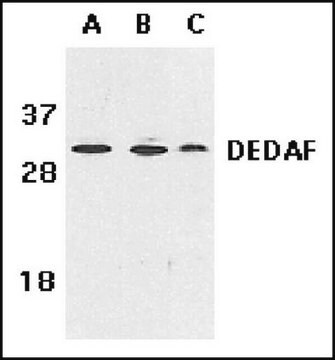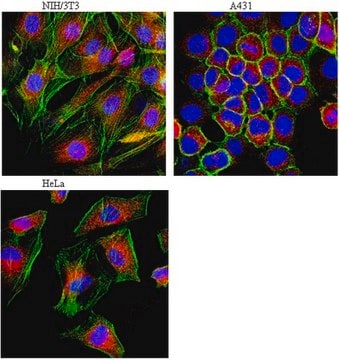ABE2864M
Anti-Meis1
from rabbit
Sinónimos:
Homebox protein Meis1
About This Item
Productos recomendados
biological source
rabbit
Quality Level
antibody form
purified antibody
antibody product type
primary antibodies
clone
polyclonal
species reactivity
mouse, human
packaging
antibody small pack of 25 μg
technique(s)
ChIP: suitable (ChIP-chip)
immunofluorescence: suitable
western blot: suitable
isotype
IgG
NCBI accession no.
target post-translational modification
unmodified
Gene Information
human ... MEIS1(4211)
mouse ... Meis1(17268)
General description
Specificity
Immunogen
Application
Epigenetics & Nuclear Function
Immunofluorescence Analysis: A representative lot detected Meis1 in adjacent stage (St) 41 sagittal hindbrain and eye sections (Mercader, N., et. al. (2005). Development. 132(18):4131-42).
Western Blotting Analysis: A 1:800 dilution from a representative lot detected Meis1 in HEK293T cells transfectd with Meis1a (Courtesy of Dr.Valeria Azcoitia and Dr. Miguel Torres).
Chromatin Immunoprecipitation (ChIP) Analysis: A representative lot detected Meis1 in Chromatin Immunoprecipitation applications (Penkov, D., et. al. (2013). Cell Rep. 3(4):1321-33).
Western Blotting Analysis: A representative lot detected Meis1 in proximal, distal, and RA-treated distal blastemas (Mercader, N., et. al. (2005). Development. 132(18):4131-42).
Quality
Western Blotting Analysis: 1 µg/mL of this antibody detected Meis1 in 10 µg of HeLa cell lysate.
Target description
Physical form
Storage and Stability
Handling Recommendations: Upon receipt and prior to removing the cap, centrifuge the vial and gently mix the solution. Aliquot into microcentrifuge tubes and store at -20°C. Avoid repeated freeze/thaw cycles, which may damage IgG and affect product performance.
Other Notes
Disclaimer
¿No encuentra el producto adecuado?
Pruebe nuestro Herramienta de selección de productos.
Storage Class
12 - Non Combustible Liquids
wgk_germany
WGK 2
flash_point_f
Not applicable
flash_point_c
Not applicable
Certificados de análisis (COA)
Busque Certificados de análisis (COA) introduciendo el número de lote del producto. Los números de lote se encuentran en la etiqueta del producto después de las palabras «Lot» o «Batch»
¿Ya tiene este producto?
Encuentre la documentación para los productos que ha comprado recientemente en la Biblioteca de documentos.
Nuestro equipo de científicos tiene experiencia en todas las áreas de investigación: Ciencias de la vida, Ciencia de los materiales, Síntesis química, Cromatografía, Analítica y muchas otras.
Póngase en contacto con el Servicio técnico







